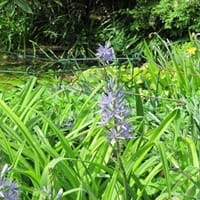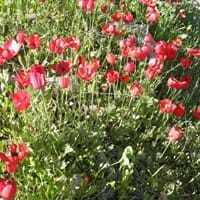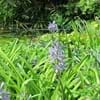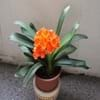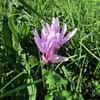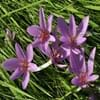Life Span
Perennial
Perennial
Type
Bulb or Corm or Tuber
Bulb or Corm or Tuber
Origin
Northwestern United States
Southern Europe, Mediterranean
Types
Camassia howellii, Camassia cusickii
Not Available
Number of Varieties
Not Available
Habitat
Depression on prairies, Hillside, meadows
damp meadows, Dry areas, Woodland edges
USDA Hardiness Zone
3-8
8-12
Habit
Upright/Erect
Upright/Erect
Flower Color
Blue, Violet, Ivory
White, Red, Blue, Pink
Flower Color Modifier
Bicolor
Bicolor
Fruit Color
Brown
Not Available
Leaf Color in Spring
Green
Green
Leaf Color in Summer
Light Green
Light Green
Leaf Color in Fall
Several shades of Green
Several shades of Green
Leaf Color in Winter
Light Green
Light Green
Leaf Shape
Long linear and narrow
Lobed
Plant Season
Spring, Summer
Spring, Winter
Sunlight
Full Sun, Partial Sun
Full Sun, Partial Sun, Partial shade
Type of Soil
Loam
Loam, Sand
The pH of Soil
Acidic, Neutral, Alkaline
Acidic, Neutral, Alkaline
Soil Drainage
Well drained
Well drained
Bloom Time
Late Spring, Early Summer
Early Spring, Spring, Late Winter, Indeterminate
Tolerances
Drought
Drought
Where to Plant?
Ground
Ground, Pot
How to Plant?
From bulbs, Seedlings
Seedlings, Tuber propagation
Plant Maintenance
Medium
Medium
Watering Requirements
Average Water Needs, Does not require lot of watering, Medium, Never Over-water, Requires watering in the growing season
Medium
In Summer
Lots of watering
Lots of watering
In Spring
Moderate
Moderate
In Winter
Average Water
Average Water
Soil pH
Acidic, Neutral, Alkaline
Acidic, Neutral, Alkaline
Soil Type
Loam
Loam, Sand
Soil Drainage Capacity
Well drained
Well drained
Sun Exposure
Full Sun, Partial Sun
Full Sun, Partial Sun, Partial shade
Pruning
Prune after flowering, Remove dead leaves
Remove damaged leaves, Remove dead branches, Remove dead leaves
Fertilizers
All-Purpose Liquid Fertilizer
All-Purpose Liquid Fertilizer
Pests and Diseases
Red blotch
Cutworms
Plant Tolerance
Drought
Drought
Flower Petal Number
Single
Single, Double, Semi-Double
Foliage Texture
Medium
Fine
Foliage Sheen
Matte
Matte
Attracts
Flying insects
Butterflies, Hummingbirds, pollinators
Allergy
Asthma
Not Available
Aesthetic Uses
Beautification, Bouquets, Ground Cover, Landscape Designing, Showy Purposes
Borders, Cottage Garden
Beauty Benefits
Not Available
Not Available
Environmental Uses
Air purification
Air purification
Medicinal Uses
Not Available
Antitumor, Cramps
Part of Plant Used
Flowers, Root
Flowers, Leaves
Other Uses
Decoration Purposes, Showy Purposes, Used As Food, Used as Ornamental plant
Unknown
Used As Indoor Plant
No
No
Used As Outdoor Plant
Yes
Yes
Garden Design
Foundation, Mixed Border, Rock Garden / Wall, Wildflower
Bedding Plant, Container, Cutflower, Mixed Border, Rock Garden / Wall
Botanical Name
CAMASSIA cusickii
ANEMONE coronaria
Common Name
Camassia, Quamash
Crown Windflower, Lilies-of-the-Field, Poppy-flowered Anemone, wind flower
In Hindi
Camassia
Poppy Flowered Anemone
In German
Camassia
Kronen-Anemone
In French
Camassia
Anémone couronnée
In Spanish
Camassia
Poppy flowered Anemone
In Greek
Camassia
Poppy Flowered Anemone
In Portuguese
Camassia
Poppy Flowered Anemone
In Polish
Camassia
Zawilec wieńcowy
In Latin
Camassia
Poppy Flowered Anemone
Phylum
Spermatophyta
Anthophyta
Class
Liliopsida
Equisetopsida
Order
Asparagales
Ranunculales
Family
Asparagaceae
Ranunculaceae
Clade
Monocots
Angiosperms, Eudicots
Tribe
Not Available
Not Available
Subfamily
Agavoideae
Not Available
Properties of Camassia and Poppy Flowered Anemone
Wondering what are the properties of Camassia and Poppy Flowered Anemone? We provide you with everything About Camassia and Poppy Flowered Anemone. Camassia doesn't have thorns and Poppy Flowered Anemone doesn't have thorns. Also Camassia does not have fragrant flowers. Camassia has allergic reactions like Asthma and Poppy Flowered Anemone has allergic reactions like Asthma. Compare all the properties and characteristics of these two plants. Find out which of these plant can be used as indoor plant. If you are interested to decorate your house and garden, find out aesthetic uses, compare them and select the plant which will beautify your surrounding. Along with beautification, try comparing medicinal and edible uses of Camassia and Poppy Flowered Anemone and you can choose the plant having best and most benefits.
Season and Care of Camassia and Poppy Flowered Anemone
Season and care of Camassia and Poppy Flowered Anemone is important to know. While considering everything about Camassia and Poppy Flowered Anemone Care, growing season is an essential factor. Camassia season is Spring and Summer and Poppy Flowered Anemone season is Spring and Summer. The type of soil for Camassia is Loam and for Poppy Flowered Anemone is Loam, Sand while the PH of soil for Camassia is Acidic, Neutral, Alkaline and for Poppy Flowered Anemone is Acidic, Neutral, Alkaline.
Camassia and Poppy Flowered Anemone Physical Information
Camassia and Poppy Flowered Anemone physical information is very important for comparison. Camassia height is 91.40 cm and width 10.20 cm whereas Poppy Flowered Anemone height is 30.50 cm and width 10.20 cm. The color specification of Camassia and Poppy Flowered Anemone are as follows:
Camassia flower color: Blue, Violet and Ivory
Camassia leaf color: Green
Poppy Flowered Anemone flower color: White, Red, Blue and Pink
- Poppy Flowered Anemone leaf color: Green
Care of Camassia and Poppy Flowered Anemone
Care of Camassia and Poppy Flowered Anemone include pruning, fertilizers, watering etc. Camassia pruning is done Prune after flowering and Remove dead leaves and Poppy Flowered Anemone pruning is done Remove damaged leaves, Remove dead branches and Remove dead leaves. In summer Camassia needs Lots of watering and in winter, it needs Average Water. Whereas, in summer Poppy Flowered Anemone needs Lots of watering and in winter, it needs Average Water.
